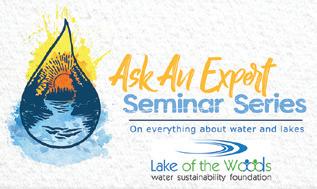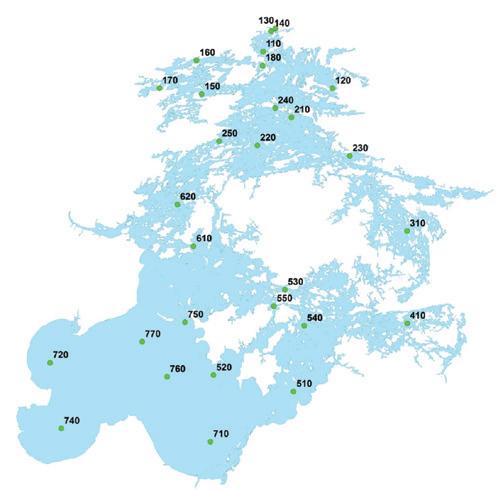
7 minute read
First step underway to scope out a phosphorus management plan
BY TODD SELLERS, EXECUTIVE DIRECTOR
Put a plan in place. Ensure there's enough science and management expertise. Coordinate actions bi-nationally. That’s our mission.
Advertisement
The Lake of the Woods Water Sustainability Foundation (LOWWSF) has launched a project to develop a framework for a future phosphorus management plan for the Canadian portion of the binational Rainy-River-Lake of the Woods watershed, with the support of a Contribution Agreement from Environment and Climate Change Canada (ECCC).
This project will scope and outline the key elements that would be required to develop a domestic phosphorus management plan collaboratively with relevant parties in the basin, once phosphorus targets are set by Canada domestically or as shared binational targets with Minnesota.
This work is timely now, to prepare for moving from research to action. In late June, the US EPA approved Minnesota’s phosphorus plan that sets phosphorus targets for each source to the Rainy River and Lake of the Woods. Next steps by Minnesota are to develop remedial action plans. In Canada, ECCC completed public engagements last spring on potential phosphorus reduction scenarios based on its four-year science program (see “What We Heard”, below). The next step would be for Canada to set targets for domestic sources as part of a phosphorus management plan to complement those being prescribed for Minnesota sources. In anticipation of this, the Foundation is preparing a proposed plan framework so that developing the plan can move forward expeditiously, with prerequisite consideration of aspects specific the Rainy River and Lake of the Woods and in collaboration with the partners that would need to be involved.

Sentinel-3 true colour satellite image and derived Chlorophyll-a concentrations, October 4, 2021.
Images courtesy of EOLakeWatch, Dr. Caren Binding, Environment and Climate Change Canada.
Fall algae bloom arrived late on Lake of the Woods
The view from space is compelling. The seasonal algae blooms were well underway at the beginning of October in the southern basin of Lake of the Woods as shown in the satellite image and associated derived chlorophyll-a data for October 4. The surface blooms had also developed through the north-central portion of the lake and into the Kenora area. Additionally, some surface blooms conditions can be seen in Ptarmigan Bay, although this could be due to a switch to strong south-easterly winds late on October 3, which may have driven surface blooms through the channel from the main northern basin of Lake of the Woods.
For much of the summer, it seemed like a "light year" for algae blooms, but blooms began to develop in the latter part of August. The low blooms in much of the mid-summer may be due to the low water and low flows from the nutrient-rich southern basin of Lake of the Woods, or perhaps lower light conditions due to the intense smoke that blanketed the lake throughout July and into the first week of August.
These satellite tools, developed by Dr. Caren Binding at ECCC, have much promise for long-term monitoring of trends in algae bloom intensity and severity. The ability of this technology is striking. Given the immense scale of our lake, these tools may prove useful as a practical way of monitoring long term changes in the lake as we begin to implement phosphorus controls.
“What We Heard” report released on public engagements with ECCC
LOWWSF has released a report summarizing what we heard from the public during engagement sessions with ECCC on its set of proposed lake ecosystem objectives and potential phosphorus reduction scenarios to improve water quality for Lake of the Woods. Hundreds participated in ten webinars and online via ECCC's Lake of the Woods engagement website. Public perception was that federal and provincial governments in Canada are lagging behind the U.S. on this issue and that Minnesota’s study is further along to the level of identifying sources and assigning specific targets and starting actions. The messages were clear—there was definitely a call to action from the public to "get on with it":
• Adopt a 20% phosphorus reduction target
• Set binational phosphorus targets
• Ensure ongoing core monitoring
• Act without further delay
The full report can be downloaded at: lowwsf.com/eccc-consultation.

Ask An Expert webinar series
The Foundation hosted a lunchtime “Ask An Expert” webinar series this fall to connect the public with some of the scientists who are working on water quality in our watershed. Although completed by the time you read this Area News, the sessions were recorded and can be viewed at: lowwsf.com/ask-an-expert.
It was a fascinating lineup with expert presentations and lots of your questions answered. The topics and experts were:
• Nutrient Export in the Canadian Tributaries to Lake of the Woods, with Dr. Catherine Eimers of Trent University.
• Minnesota’s Plan to Identify and Address Excess Phosphorus Pollution in Lake of the Woods and its Watershed, 1999-2021, with Jesse Anderson, lead scientist with the MPCA for the Rainy River and Lake of the Woods.
• Lake of the Woods from Space: Satellite Observations for Algal Bloom Monitoring, led by Dr. Caren Binding of Environment and Climate Change Canada.
• Lake of the Woods: A Story of Pollution, Recovery, and the Road Ahead, led by Dr. Adam Heathcote of the Science Museum of Minnesota.
• Climate Change and its Effects on Lake Ecosystems in Northwestern Ontario, with Dr. Scott Higgins of the IISD - Experimental Lakes Area.
We are very fortunate to have access to these dedicated, knowledgeable experts and we thank them for bringing the science to the community in such an effective way. If you missed the webinars, please view the recordings online at the Foundation’s website.
Zebra mussels discovered in Rainy Lake
Disappointing news. Zebra mussel larvae have been confirmed in Rainy Lake by the Minnesota Department of Natural Resources (MN DNR). Adult reproductive colonies have not yet been located or confirmed. The larvae were found in four of five water samples taken in July 2021, suggesting that there is a reproducing population in the lake according to MN DNR. This follows on an unconfirmed report of larvae in 2020 by a member of the public. Rainy Lake straddles the OntarioMinnesota border and flows downstream via the Rainy River to Lake of the Woods. This follows equally concerning confirmations by MN DNR in 2019 and 2020 of zebra mussel larvae at sites in the southern portion of Lake of the Woods.
2021 results are not in yet from MN DNR. To date, reproductive colonies have not been located in Lake of the Woods.

Location of ECCC’s 28 monitoring sites on Lake of the Woods, September 2021 (ECCC graphic).
2022 Watershed Forum – Save the date!
March 9 – 10, 2022 all eyes will focus again on our watershed, lakes and rivers at the 19th International Rainy-Lake of the Woods Watershed Forum. The 2022 Forum will feature special sessions on emerging vulnerabilities, zebra mussels and other aquatic invasive species, in addition to the usual topics that include fisheries, climate change and more!
Like last year, the Forum will be held virtually as an online event, due to continued uncertainty about cross border travel. We were able to host a high-quality online event last year, with the support of St. Cloud State University’s IT / Video Conferencing department and will do so again, but we can’t wait to convene in person in 2023. More information about the Forum is available now and more details will roll out (including the program and attendee registration) over the winter at the Foundation’s website: lowwsf.com/watershed-forum
Canada’s Water Quality Monitoring back on Lake of the Woods this fall
Environment and Climate Change Canada’s team responsible for sampling water quality on Lake of the Woods was out this September doing a lake-wide survey of 28 sites (see map). Water quality sampling had been paused last year due to COVID-19 restrictions. In addition, they re-initiated their long-term monitoring of the Rainy River inflow to Lake of the Woods and the Winnipeg River outflow.
At each site, water quality parameters measured included: phosphorous, nitrogen, carbon and their various forms, total and dissolved metals, major ions, Chlorophyll a, Phycocyanin (an algal pigment found in blue-green algae), total suspended solids, algal toxins and taxonomy, Secchi depths, dissolved oxygen, pH, turbidity, conductivity and temperature. September samples were taken at the surface, at 1m depth and at 2m off the bottom. If the water column was stratified and had an identifiable thermocline, an integrated sample of the epilimnion (surface to thermocline) was taken.
Given the proliferation of algae blooms this past month, an extra bonus is that this sampling has allowed for further calibration of the satellite remote sensing models that use satellite imagery to indicate bloom extent and severity.

Several projects reported on in this article are undertaken with the financial support of the Government of Canada through the Federal Department of Environment and Climate Change Canada.










